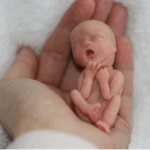Introduction
The short answer to the title question: “Is Abortion Eugenics?” is: Yes, abortion (i.e., contemporary abortion-choice policy) can qualify as eugenics wherever a children-in-utero is intentionally terminated for any number of reasons deemed ‘defects’ in the child.
Preliminary reasons for this answer are that:
(1) eugenic abortion is a standing legal term describing any abortions conducted for eugenic reasons;
(2) the concept of eugenics never required the coercive laws and pseudo-science with which it was associated in the early 20th century;
(3) the onset of genetic testing has greatly enabled our predictive ability regarding fetal health, thus giving us a window of opportunity to abort a child before he or she is born with a genetic defect; and
(4) and even with non-genetic defects–that is, traits which aren’t transferred to the child’s future offspring–these are still, by definition, defects and would qualify a child as “defective offspring”, thus satisfying the minimum criteria for eugenic target practice. Aborting such children-in-utero due to their perceived “defects” would still be an effort to improve the “stock” of the next generation of children, and so would qualify as eugenics at least in the broadest conceptual sense of eugenics.
That’s the short answer and four reasons for affirming it. But that answer might not satisfy audiences who aren’t aware of the backstory to this ethical issue. Eugenics and abortion have similar but different histories which have set these concepts on an interwoven path across modern history; they sometimes overlap and sometimes diverge. For this article we will focus on the definitional history of eugenics to see how and why abortion might qualify as eugenics.
What is Eugenics?
“Eugenics” was once a daring idea swirling around elite conversations 100 years ago, in medical schools, science conferences, and political boardrooms. Today, the term is rarely heard except to insult contentious policies and programs. In the abortion debate, the term “eugenics” occasionally appears in reference to “eugenic abortion” but often, it too is intended as slander. So we are left with a preliminary question of what exactly is “eugenics” and more to the point, does abortion–in any significant sense–qualify as “eugenics”?
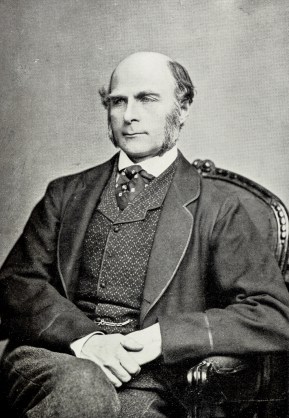
Francis Galton, a famous victorian era Scientist, cousin to Charles Darwin, avowed evolutionist, political progressive, and outspoken social engineer, is credited with first coining the term “eugenics” in 1883 [here and here]. He would eventually pioneer a scientific field under that title, “eugenic science” along with fellow eugenicists of the time like Herbert Spencer, and Frederick Osborn, and others. Galton invented and defined the term “eugenics” by drawing from the Greek root eu, meaning “well/good” as in eulogy (“good word”) and euphoria (“bearing well”) and genus meaning “birth” as in genetics. Together they become eugenes a Greek word meaning “noble birth.” From that term he derived an English cognate “eugenics” expanding the concept from “noble” birth into “good” birth (the root eucould signify nobility or goodness). However, that broad understanding of the term isn’t very specific. It doesn’t tell us what Galton means in the phrase “good birth.”
Galton goes on to explain the term by loosely sliding between human and animal eugenics, as the concept was common fair within animal husbandry. He sees it simply as the “science of improving stock.”
[W]ith questions bearing on what is termed in Greek, eugenes namely, good in stock, hereditarily endowed with noble qualities. This, and the allied words, eugeneia, etc., are equally applicable to men, brutes, and plants. We greatly want a brief word to express the science of improving stock, which is by no means confine to questions of judicious mating, but which, especially in the case of man, takes cognisance of all influences that tend in however remote a degree to give to the more suitable racesor strains of blood a better chance of prevailing speedily over the less suitable than they otherwise would have had. The word eugenics would sufficiently express the idea; it is at least a neater word and a more generalised one than viriculture which I once ventured to use. [Francis Galton, “Human Faculty,” (1883), pg. 17; emphasis mine].
Galton has a lot to say here, but for the sake of focus we’ll only note a few implications (underlined above) as they relate to the discussion.
1) Galton uses the term “viriculture” as a synonym for “eugenics,” potentially implying some element of “culture.” In this passage and others, Galton seems to understand eugenics as intentionally and directly dealing with culture somehow in the form of or through heritable traits.
2) When he says “suitable races” A brief perusal of the rest of the book, as well as outside sourcing confirms that Galton had in mind the “racial evolution of the human species” (Roswell Johnson, “Eugenics and So-Called Eugenics,” American Journal of Sociology, Vol. 20 no. 1 [1914], 98.).
3) The phrase “noble qualities”, borrowing from the Greek eugenes (“noble birth”), includes attributes that we now know to be genetically inherited (ex., skin color), as well as some things that we now know are not genetically inherited, for example, propensity for wealth/poverty. These overzealous guesses about heredity are a big part of what eventually discredited eugenics.
4) Galton “by no means confine[s]” eugenics to “judicious mating” that is, positive eugenics (encouraging breeding among “preferred stock). Thus he also has in view negative eugenics (discouraging breeding among defective stock).
5) Galton seeks to be “cognizant of all influences” which lend advantage to some and disadvantage to others. In this same line he mentions viriculture as a somewhat narrower synonym. Galton does not seem to be limiting his concept of inheritance to strictly biological modes (such as genetics).
Our purpose here isn’t to detail the whole history and downfall of eugenics, or even to preoccupy ourselves with the eugenics work of Galton. Rather, the effort is to establish a historically informed root sense of the term whereby we can judge whether abortion qualifies in any significant sense.
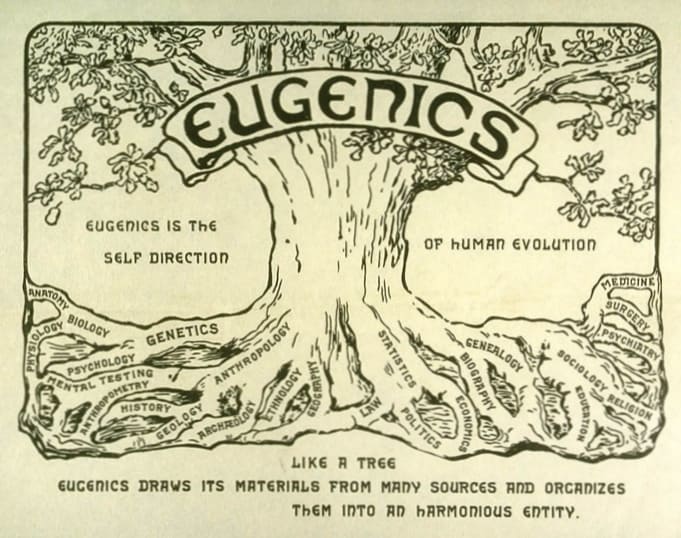 The ‘Eugenics Tree’ developed and circulated by the National Eugenics Office (c. 1921) was a prominent logo and conceptual description of the eugenics movement.
The ‘Eugenics Tree’ developed and circulated by the National Eugenics Office (c. 1921) was a prominent logo and conceptual description of the eugenics movement.
Galton was not dealing in a “new” concept, but rather a new application of an old concept. Eugenics was already at play in animal husbandry. It was not common at the time, however, to think of mankind as merely another species of animal. the more common view was some brand of creation doctrine (whether biblical, deistic, or otherwise). Creation doctrine was common in the 19th century, even among top tier scientists, and while that doesn’t require any single religious or textual tradition, it does tend to set apart mankind as a “special creation” innately distinct from the other animals. But creation doctrine met it’s stiffest competition in 1859 when Charles Darwin published Origin of Species. Soon Darwins model of evolution skyrocketed to the top of international scientific interests. As Darwin’s theories saturated the market, mankind was increasingly seen in dimmer (and fiercer) lights. Man was thought to be on the same living continuum with the other animals, not some “specially created” entity radically distinct from other animals. Under this new paradigm, it was only natural for Galton to transition in thought from animal husbandry to human breeding. The same goes for Darwin. His follow-up book, Descent of Man (1972) is riddled with the “good breeding” rhetoric seen later in Galton’s writing (see, John West, Darwin Day in America [2007], pgs. 31-33, 128-130).
But the early notion of eugenics veers far wide of the modern definition of eugenics. In the late 19th and early 20th century, eugenicists tended to define “eugenics” with reference to heredity generally, and not genetics specifically. They lacked the hard science to narrow down “heredity” to genetic factors, yet instead of proceeding with caution and humility, they instead marched boldly forward entwining eugenics with overtly racist agendas (ala, Hitler’s “racial hygiene” program), and ad hoc/pseudoscientific theories like phrenology (the study of personality/character via skull shape). Early eugenics programs also earned great scorn by operating within a context of forced sterilization, a practice that has since been judicially overturned (Skinner vs. Oklahma [1942]). For these reasons it’s clear why eugenics has a bad reputation and would be a slanderous accusation today.
In summary so far, eugenics refers to the theory and practices involved in generating “good stock” of human progeny, whether in one generation or in many future generations. Eugenics was conducted as a “science” but much of it has been shown to be pseudoscience (including scientific racism, phrenology, and hereditary poverty, etc.) Eugenics may be positive, encouraging “good” parents to breed; or negative, discouraging “bad” parents from breeding. We’ll call this the “broad sense” of eugenics. the early eugenicists tended to include race and poverty in their estimations of “good” and “bad” stock, and they were even able to pass U.S. law institutionally approving forced sterilization for “defective” people, as they were deemed unfit to breed.
This historically rooted understanding of eugenics, may be termed the “broad sense” of eugenics (i.e., facilitating “good stock”) and comports with it’s definition as found in dictionaries of etymology such as OnlineEtymologyDictionary
“[E]ugenics (n): doctrine of progress in evolution of the human race, race-culture,” 1883, coined (along with adjective eugenic) by English scientist Francis Galton (1822-1911) on analogy of ethics, physics, etc. from Greek eugenes “well-born, of good stock, of noble race,” from eu- “good” (see eu-) + genos “birth” (see genus). . . . The investigation of human eugenics, that is, of the conditions under which men of a high type are produced. [Galton, “Human Faculty,” 1883] [Online Etymology Dictionary]
The broad sense is also found in older encyclopedias and dictionaries which were contemporary to the eugenics movement.
EUGENICS (from the Gr. . . well born), the modern name given to the science which deals with the influences which improve the inborn qualities of a race, but more particularly with those which develop them to the utmost advantage, and which generally serves to disseminate knowledge and encourage action in the direction of perpetuating a higher racial standard. [Encyclopedia Brittanica (1911)].
The study of hereditary and environmental influences, for the purpose of improving the physical and mental qualities of future generations. [New Catholic Dictionary (1910)]
[Eugenics] (n.) The science of improving stock, whether human or animal. [Websters Dictionary, 1910]
Eugenics literally means “good breeding”. It is defined as the study of agencies under social control that may improve or impair the racial qualities of future generations either physically or mentally. [The Catholic Encyclopedia (1914)].
We should point out, that the “broad sense” allows for, but doesn’t require, eugenics to be a science, that is, a clinical field of study and practice dealing in objective facts and practices. But even if it were proven to be pseudoscience, eugenics would still be about “improving human stock.” Eugenics is also affiliated with sterilization practices, as that was once a popular means of eugenics. But, even if other means were used–such as abortion, euthanasia, infanticide, or even death camps–it would still be eugenics if it actually or was intended to achieve (what was thought to be) “improved human stock.” Also, eugenics is often associated with coercion, such as forced sterilization. But again, it would still be eugenics if people voluntarily underwent sterilization or conducted their mating practices according to eugenic principles.
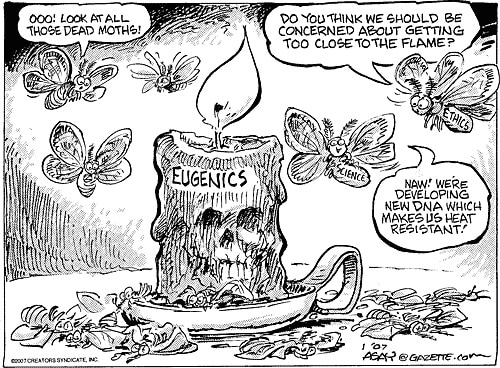
We should also note that the parallels between animal husbandry and human breeding practices are only rough parallels. In animal husbandry it’s not uncommon to kill feeble newborns or relatively healthy but older members of the herd. Obviously, Hitler’s “racial hygiene” program–which included these sorts of practices–would qualify as “eugenics.” But that extreme use of eugenic theory was never normalized in the U.S. Nevertheless, eugenics can refer to any measures whatsoever which are intended to socially engineer improved stock on a human population, but the term appears to also be used in a narrower sense, in reference to the ideology, laws and practices which composed the sterilization laws of the early 20th century.
Institutionalized eugenics laws have since been halted, practically abolishing the most common point of reference for “eugenics.” There does, however, exist a category of abortion called “eugenic” abortion. The broad sense of eugenics appears to be at work here. Duhaime’s law dictionary defines eugenics as: “A measure taken to avoid or prevent the birth of a defective child” (Speck vs. Feingold [1979], ftnt 4). This definition admits the notion of a “defective child” but does not restrict that notion to genetically defective children. Nor is there any mention of coercion, sterilization, or even science. The entry continues,
“[A] eugenic abortion (is) one directed solely to eliminate a potentially defective fetus.” (Hummel v. Reiss, 1991].
Duhaime’s broadness is important for legal purposes. In the court of law, medical and scientific nuances are not necessarily in focus. A defendant could be aborting her child for eugenic concerns (broadly) irrespective of the more “evolved” or scientifically informed notions of heredity. She could ascribe even to the “racial hygiene” ideas of White supremicists, and consider her child unworthy of life for being the product of a racially mixed father. For legal purposes, the broad definition of eugenics, and eugenic abortion, is important lest our court system definitionally exclude real causal forces. That is, people may believe pseudoscientific theories, or ascribe to a racist worldview, or have otherwise distorted ideas about heredity and what counts as “good birth.” Or they could even kill their unborn child because of concerns about environment and culture. And regardless of how legitimate or illegitimate these beliefs may be, they can causally affect people’s reproductive choices. This legal definition therefor refrains from ruling unnecessarily on these details thus allowing litigants to hash it out in future cases.
Another reason for asserting the reality of this broad sense of eugenics is because of it’s semantic family, in particular, the adjective “eugenic” which means:
“pertaining to or causing improvement in the type of offspring produced. Compare dysgenic.” [TheFreeDictionary]
The adjective “eugenic” may include genetic degradation/defect, but it doesn’t have to. It points out anything pertaining to or causing, what is perceived to be, some sort of improvement among offspring.
The antonym, dysgenic, shows the same bivalent meaning, as “eugenics” does (above), but it does so from the opposing side. Whereas eugenics can refer to either improved human stock generally, or improving the human gene pool specifically, the term dysgenic can refer to either genetic defects or to defects generally–it depends on which dictionary is cited.
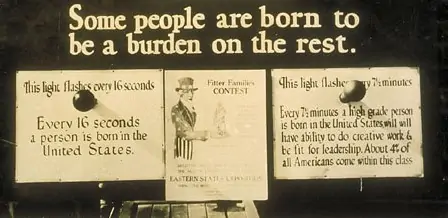
Still another reason for rejecting the strictly “genetic” sense of eugenics is that in the U.S. and especially in Germany, eugenics are argued on the basis of the burdening impact of handicapped or otherwise “defective” offspring on society. Whether a trait is genetically based or not is secondary to the fact that a particular child is still considered a burden to society and a poor use of resources. This “burden” is especially heavy, and precariously positioned, in countries with socialized healthcare, government welfare, and otherwise federally funded social programs where the tax burden for these “undesirables” is spread out across populations of people who don’t necessarily want to see their tax dollars funding someone else’s “irresponsible” family planning practices. Children who have non-heritable conditions which nonetheless restrict their ability to serve productively in military or in the labor force are still seen, by this logic, as “burdens” to society.
We may safely conclude, that there is a literal and factual sense in which eugenics refers broadly to “intentional/planned measures to improve human stock” and the various measures so far identified with this concept have so far proven unseemly, including force sterilization, euthanasia, prison camps, and eugenic abortion.
The Genetic Shift
More recently, somewhere around the mid-20th century to today, the term “eugenics” has come to be understood in a way that narrows and restricts the semantic range of eugenics. Most notably, eugenics is interpreted with reference not simply to “inherited traits” generally but in terms of the mode of inheritance as well, that is, genetics. Eugenics was, in many ways, a facet of the pioneering efforts of genetic science. We see this shift commonly in medical dictionaries–wherein motive, history, legality are not necessarily in view.
“Practices and genetic counseling directed to anticipating genetic disabilityand disease”
(Farlax Partners Medical Dictionary [2012]).“Eugenics: A pseudoscience with the stated aim of improving the geneticconstitution of the human species by selective breeding.” (WebMD [last updated 5/13/2016])
“eugenics: . . . . 2. Practices and genetic counseling directed to anticipating genetic disability and disease.” (Stedman’s Medical Dictionary [1998])
Countless bioethics journals and books follow suit forewarning about the intersection of eugenics and more recent genetic technology such as genetic testing and genetic engineering in one’s offspring (for example, see here, here, and here). It is safe to say that the genetic sense of “eugenics” is the normal sense of the term today.
There are several possible reasons why modern dictionary entries, such as these, would acknowledge a genetic component to eugenics (as opposed to a more general “heredity” definition ala, Galton, Herbert Spencer, and Frederick Osborn). The most obvious reason is that eugenics is primarily concerned with heredity, and the prime mover in heredity–according to the best efforts of modern science–is genetics. Anyone who might take eugenics seriously today or who would attempt to argue academically for some updated brand of eugenics would be entirely dismissed if he or she left out genetics. Indeed, the American Eugenics Society (1926-1972), or AES, survived right up to the year of Row v. Wade (1973). And AES uses the following definition:
“[Eugenics is] the study of improving the genetic composition of humans through controlled reproduction of different races and classes of people.” (Quoted by Rachel Gur Arie, 2014)
The American Eugenics Society survived for decades after WWII, even though institutionalized eugenics (meaning sterilization programs) was banned. When Watson and Crick pioneered the theory of DNA, uncovering it’s mysterious linguistic code in 1953, the notion of “heredity” underwent a monumental shift. Sure, genetics was a standing convention in the sciences by that time, but DNA based genetics was now the scientific concensus–fully establishing Darwin’s model of evolution (including classical and Neo-Darwinism/Modern Synthesis) over and above alternative models like Larmarkism. The AES, at least since the 1942 Oklahoma vs. Skinner case, had every reason to adapt their “store front” version of eugenics to suit new discoveries and distance themselves from the more regrettable and unsavory affiliations (animal breeding, coercion, racism, etc.).
Now, of course, genetics isn’t the only means of inheriting traits from one’s parents. There is also culture and environment, the “Nurture” part of the nature-nurture dichotomy. We see this adaptation in the work of one of the most famous eugenicists, Frederick Osborne (1889-1981) who presided over the AES in 1946 (after forced sterilization was banned), and in 1954 founded the journal Eugenics Quarterly (later, changed to Social Biology). He argued for a non-coercive, and scientifically neutral, brand of eugenic anthropology which dealt in culturally transmitted traits; indeed, he was skeptical of the “hereditarian” model which attributed most every socially derelict quality to biological heredity (source).
We also know that non-genetic factors can influence gestation and development in pregnant mothers. The pregnant mother can impart anything traceable to the shared blood and nutrients with the fetal child, including any bacteria, viruses, or other contaminates that may enter through the umbilical cord. Where any of these blood-born contaminates are thought to be or cause “defective” status they would qualify as eugenics. A key example might be fetal-alcohol syndrome. These case would be eugenic in the looser sense of the term–as unseemly “burdens” on society. But if the reader finds that usage unsightly, it could be term “eugenics-like” as it’s follows similar logic and appears in the same ballpark with historic uses of the term (prior to modern genetics) but does not include the genetic component found in modern definitions.

Eugenics is considered pseudoscience today, but it was once considered good sound science and that meant it’s reputation hung on its ability to keep pace with the best developments in hereditary science at the time, otherwise it would lose any persuasive claim on science. Put another way, eugenics itself evolved over time. Eugenics, as a field of study and practice, adapted to survive the growing hostility against eugenics that arose in the mid to late 20th century. Numerous U.S. states had eugenics laws on the books between 1900-1941, and Hitler reportedly drew much of his inspiration from U.S. law codes in this respect. Hitler of course, died in infamy, and the ideological baggage of the 3rd Reich went down in infamy with him including his theories of “racial hygiene”, a brand of eugenics, which eventuated the death of millions of feeble and mentally ill people, Jews, Blacks, Gypsies, and other people deemed “defective.” Back in North America, U.S. eugenics laws were effectively dissolved with the combined impact of Hitler’s infamy and the Oklahoma vs. Skinner case of 1942 which ruled against the practice of forced sterilization.
Here we should be careful not to mistake different phenomena masquerading under the same name. In one sense there is the socio-historical institution of “eugenics,” that is, legislative and judicial acts which established certain practices intended to improve the “human stock” (aka, genetic stock/racial stock). In this sense, “eugenics” was overturned. Eugenics laws, from the early 1900’s, no longer applies today.
In another sense, there is the scientific theory which entailed scientific racism, and a bevy of bad science practices which purported to show that human populations could be objectively improved through selective breeding practices. This sense of “eugenics” has been debunked as pseudo-science.
In still another sense, eugenics is, philosophically speaking, “the science of improving human populations.” And while that “improvement” is typically understood with reference to functionally advantageous or societally preferred genetically-based attributes, the genetic component is the commonly accepted means of heritable transference, genetics is not the intrinsic “end-goal” of eugenics. So long as a parent somehow passes on an effect to his or her child, then it is affecting the next generation–whether for one generation (i.e., non-genetic traits) or all future generations (i.e., genetic traits). Compared to the other two, the philosophic sense of eugenics is not so easy to discard. Sure we can still object to eugenic practice or eugenic laws , but we can hardly suggest that the theory is incoherent or that it’s neatly distinguished from abortion.
Is Abortion Eugenics?
So we return to the original question: Is abortion eugenics? The answer to this question depends on what kind of abortion we’re talking about. Some kinds of abortion are clearly selecting for “preferred” genetic lines, hence the ethical conundrum with fetal genetic testing (ex., amniocentesis). There is no real question about whether this sort of practice is common, for example, for Down Syndrome children-in-utero, or whether Down-Syndrome is a genetic condition, or whether Down-Syndrome people are able to reproduce later in life. Since all of these are facts, there exists a real and literal sense of “eugenics” in abortion. Hence we still have the somewhat contentious, but nonetheless accurate term “eugenic abortion” (Hummel vs. Reiss, 1991).
But other kinds of abortion have no eugenic intention nor eugenic effect. Some women abort their children-in-utero without any intended or resultant social benefit. Now there may be an abstract or general senses of beneficence at work here–preventing one more unwanted child, or one more mouth to feed, or one more financial burden on society and that might approximate “eugenics”–but we can admit that at least in some cases, women have abortions which have no eugenic intentions or eugenic outcomes.
A tricky middle ground can be found with non-genetic but still inherited “defective” traits (and “defective” could be any agreed-upon traits like gross deformity or really anything deemed as such in the eyes of the beholder). If a woman were to somehow harm her child-in-utero, for example, through fetal alcohol syndrome, drug addiction, or viral and bacterial contagions (or any effects therein) and she were to abort that child-in-utero she is still contributing to a “purer” stock of children. She’s “thinning the herd” of malformed, sick, feeble, or otherwise “defective” children. This practice is entirely consistent with the early notions of eugenics (Galton, et al.). And it’s only trivially different from modern “genetic” definitions of the term. Nowhere do the founders, or even the later fathers of the Eugenics movement require that a trait extend beyond one generation (thus qualifying as genetic heredity) before it can count as a “defect.” Some defects only affect the immediate generation, other defects commune across several generations. Eugenics is aimed against “defective” offspring, regardless of how transferrable that defect may be across multiple generations.
One can try to argue that only genetic inheritance qualifies as eugenics. Indeed a wide range of academic sources presume as much. But that “narrow definition” doesn’t explain the evidence as well as the broad-definition of eugenics does.
1) Even today, we know that genetics are not the only means of inheriting qualities from one’s parents. There is also viruses, bacteria, epigenetics, and of course anything that might qualify as “nurture” (culture, upbringing, environment).
2) Bearing in mind Galton’s inspiration for the term eugenics was animal husbandry, breeders sometimes have to “cull the herd” for reasons besides genetic inheritance. They may kill injured and subsequently disabled animals–thus improving the relative health of the herd for that generation of animals. Or they may kill animals with dangerous or otherwise problematic learned behavior. Dogs for example may be put down because they were attacked so much that they became violent and untrainable. Again, these practices are still “improving the herd” for one generation even if they don’t trace the problem to genetics.
3) The adjectival sense of “eugenic” has a wide semantic domain meaning “well born” or “fitting for those who are well born/preferred stock.” This sense isn’t limited to genetics.
3) The Greek word, eugenes, from which Galton derived the English cognate “eugenics” means simply “good/noble birth” and includes culture, environment, and primarily family name (i.e., inheritance rights) within it’s notion of beneficial inheritance. Good hereditary standing, was more than just genetics.
4) Frederick Osborn and his followers established a real, albeit minority, account of eugenics in terms of cultural heredity.
5) “Eugenic abortion” is defined as late as 1979 in terms of “defect” yet only some defects are genetically caused (Hummel vs. Reiss, 1991).
6) Using eugenic-type methods to improve a population or family line for one generation would still be eugenic in spirit, even if there is no genetic mode of transmission into further generations. It would be oddly trivial to draw a thick dark line between “eugenics” and “selectively aborting defective children-in-utero whose defects aren’t transferrable to future generations.” Both refer to “improving the stock” even if genetic transmission stretches further into the future.
7) There exists a budding field of epigenetics which leaves the door open for heritable but non-genetic traits–which could potentially continue on for many generations as if it were genetic. In this way, genetic science itself is still evolving and may have to embrace significant modifications to account for our biological blueprints and the interpreters of those blueprints.
8) There appears to exist at least two senses of the term “eugenics” one being the stricter “genetic” sense and the other being the broader classical sense of Galton (and others) which did not specify or require any particular mode of heredity.
9) Imagine that congress were to pass a bill paying poor people a large sum to get sterilized in an effort to “cure poverty” by destroying the reproductive potential in cultures of poverty. Notice, this scenarios directly admits that poverty is cultural, not genetic. That scenario would defy the narrow genetic sense of eugenics, but it seems to obviously qualify as eugenics since it would be manipulating circumstances to eventuate “better stock.”
Conclusion: Abortion Is Eugenics
What’s the answer? Abortion is clearly a means of eugenics, most explicitly in cases aborting genetically handicapped children-in-utero, such as down syndrome cases. Secondarily, abortion can also qualify as eugenics in the broader, classical sense of the term, wherever people are terminating the life of a child-in-utero to reduce the incidence of physiological or even psychological “defects” (however they define/understand the notion of “defect”). Third, eugenic abortion is a real and defensible term, as it describes the easily demonstrated fact that some people conduct abortions for the purpose of eliminating unwanted traits among the next generation of children. Fourth, we can admit that institutional coercion and “scientific” brands of eugenics have been overturned and their contribution to the larger concept of eugenics is effectively debunked–hopefully they are buried forever. There may persist scientifically neutral forms of eugenics, which do not import scientific racism or any other pseudoscience, but we have great reason to leave the worst excesses in the name of “eugenics” buried, never to see the light of day again.












